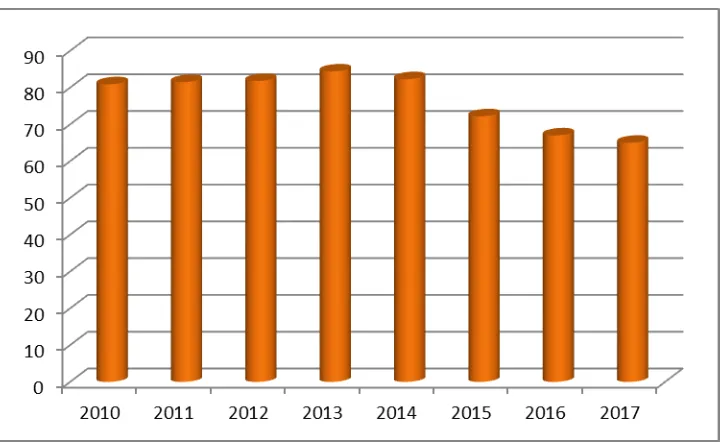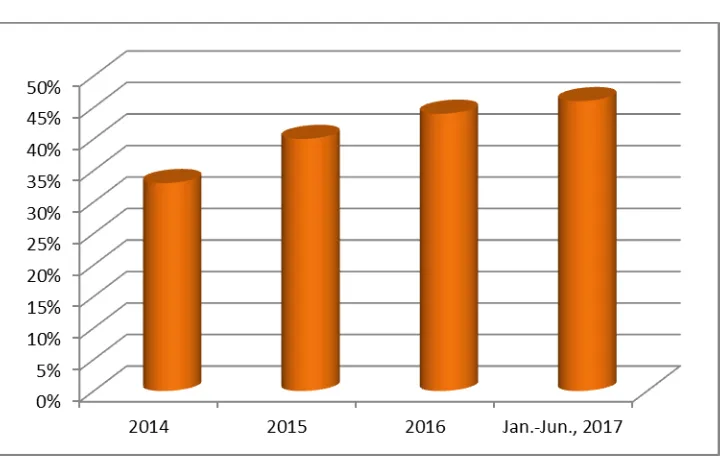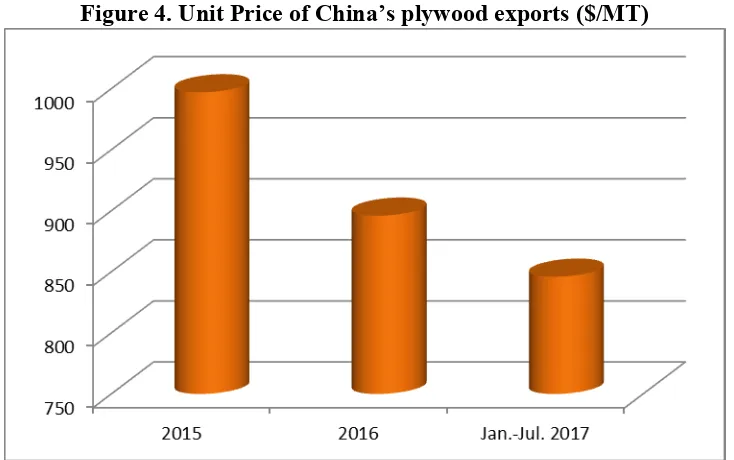THIS REPORT CONTAINS ASSESSMENTS OF COMMODITY AND TRADE ISSUES MADE BY USDA STAFF AND NOT NECESSARILY STATEMENTS OF OFFICIAL U.S. GOVERNMENT POLICY
-
Date: GAIN Report Number:
Post:
Report Categories:
Approved By:
Prepared By:
Report Highlights:
China’s imports of wood products are forecast to continue increasing in 2017. The increase is in response to a decline in domestic production despite a strong domestic demand. Starting in early 2016, China banned commercial logging in natural forests to allow forests to recover from decades of over-logging and to help restore forest ecosystems. This ban is estimated to reduce China’s wood production by about 50 million cubic meters (m3), an estimated 8 percent of total production. Hence, in the next three to five years, China will need to import more timber to compensate for the reduction in domestic timber production as a result of the ban. Meanwhile, China’s overall wood product exports are
expected to remain stable in the coming years. Jennifer Clever
Michael Ward Wood Products
Strong Domestic Demand and Declining Production
Encourage Wood Imports in 2017
Beijing
China - Peoples Republic of
CH17061 11/6/2017 Public
2 Executive Summary:
China reduced its logging quota for 2016-2020 to 254 million cubic meters (m3). This is compared to a quota of 271 million m3 in 2011-2015. Starting in early 2016, China banned commercial logging in natural forests to allow forests to recover from decades of over-logging and to help restore forest ecosystems. As a result of this ban, China’s timber production will decrease in the near future. Hence, timber imports are expected to increase to compensate for the lower domestic production. Meanwhile, China’s overall wood product exports are expected to remain stable in the coming years.
Forest General Situation
China’s forest coverage stands at 21.6 percent and is targeted to increase to 23 percent by 2020. According to China’s 8th National Forest Resources Census (2009-2013), China’s forest area covers 208 million hectares (ha) with total standing wood volume at 16.4 billion cubic meters (m3) and forest stocking volume at 15.1 billion m3. China’s natural forest area is 122 million ha and plantation area is 69 million ha. China’s forest area ranks the 5th in the world, after Russia, Brazil, Canada and the United States. China owns the largest plantation area in the world.
In May 2016, China’s State Forestry Administration (SFA) released the 13th Five-Year Plan for Forestry Development. The plan aims to increase China’s forest coverage rate to 23.04 percent and forest stocking volume to 16.5 billion m3 by 2020. To reach this goal, the plan also states that China will plant 33.33 million ha of forests during 2016-2020. In the first half of 2017, China planted 4.4 million hectares of forest, accounting for 66 percent of China’s planting plan for 2017.
China is increasingly interested in promoting forest management and chain of custody (COC)
certification as key international export markets, such as European Union and the United States, have strict market access requirements on imports of sustainable wood products. There are three major forest certificate schemes in China – The China Forest Certification Scheme (CFCS), the Programme for the Endorsement of Forest Certification (PEFC), and the Forest Stewardship Council (FSC). In February 2014, the PEFC endorsed the CFCS. This international endorsement and recognition of China’s forest certificate scheme will continue to facilitate exports of Chinese wood products to traditional export markets, especially Europe.
Table 1. China’s Forest Certification Situation (as of June 2017)
CFCS PEFC FSC
Certified Forests Area (1,000 ha) 8,677 N/A 988 Certified Forest Management Companies 53 45 N/A
Certified COC Companies 33 433 5200
3
In early 2016, China announced a reduction to its logging quota for 2016-2020 to 254 million m3. The logging quota during 2011-2015 was 271 million m3 (see Table 2 below for comparison of logging quotas). It should be noted that the quota for natural forest logging is for non-commercial logging1 given China’s ban on commercial logging in all natural forests imposed since the beginning of 2016. This ban was initially scheduled to come into effect in 2017. However, after two years of pilot programs in Northeastern China, where the largest natural forests are located, in 2016 the Chinese government decided to expand the logging ban to cover natural forests nationwide. The nationwide ban intends to allow forests to recover from decades of over-logging and help restore forest
ecosystems.
It is estimated that the logging ban on natural forests would reduce China’s wood production by about 50 million m3, which would impact China’s wood supply in the short term. China has been very ambitious in expanding its plantation area to compensate for the supply gap resulting from the ban on natural forest logging. In 2013, China launched the construction of the Strategic Timber Reserve Base (STSB) and aimed to expand it to 14 million ha by 2020. If this can be accomplished as planned, it is estimated that the STSB would increase China’s wood supply by about 95 million m3. However, Chinese industry observers highlight that some timber from natural forests cannot be easily substituted with timber from plantation forests, especially high-end timber. Therefore, in the next three to five years, China will need to import more timber to compensate for the reduction in domestic timber production as a result of the ban.
Table 2. Logging Quota Comparison
(Million m3)
2016-2020 2011-2015
Total logging quota 254 271
Natural forest logging quota 49.5 82.7
Plantation logging quota 204.5 188.3
Solid Wood Products Situation & Outlook
China’s timber production is expected to decline to 63 million cubic meters (m3) in 2017 from the estimated 67 million m3 in 2016. As mentioned above, the decline is the result of the ban on commercial logging in natural forests. From 2010-2014, China’s timber production held steadily at around 80 million m3. However, in 2015, timber production declined to around 70 million m3 due to the pilot project introducing logging bans in natural forests in northeastern China (see figure 1 below).
Figure 1. China’s Timber Production 2010-2017 (million m3)
1
4
(Source: China Forestry Statistical Yearbook by SFA. 2017 data is Post’s estimation)
China’s 2017 log production is forecast at 59 million m3, about 5 percent lower than the estimated 62 million m3 in 2016. The forecast decline is supported by the reduction in timber
production. Conversely, China’s 2017 lumber production is forecast at 80 million m3, about four percent higher than the estimated 77 million m3 in 2016. China’s lumber production is not consistent with trends in log production because lumber production also includes production with imported logs.
China remains the largest wood based panel producer in the world. China’s 2017 wood based panel production is forecast at 315 million m3, about four percent higher than the estimated 302 million m3 in 2016. Plywood accounts for about 60 percent of China’s total wood based panel production, followed by fiberboard, and particle board.
Figure 2. China’s Wood Based Panel Production in 2015
(Source: China Forestry Statistical Yearbook by SFA)
5
manufacturers, and 400 particle board manufacturers. Geographically speaking, China’s wood based panel production is relatively concentrated in east China. Wood based panel production in Shandong, Jiangsu, Anhui, Henan and Hebei province account for about 60 percent of China’s total
production. However, the industry concentration ratio is very low because over 90 percent of China’s wood based panel manufacturers are privately owned and small-scale.
As one of the largest wood furniture producers in the world, China produces over 250 million pieces of wood furniture annually. Guangdong, Fujian, Zhejiang, Shandong, Jiangxi, Sichuan and Henan are largest wood furniture producers in China, accounting for over 70 percent of China’s total wood furniture production. According to the China Furniture Association, domestic furniture sales increased to 79 percent of total sales in 2016, compared to 74 percent in 2013. This increase indicates that more imported wood stayed within China rather than re-exported.
Trade
Overall, wood products imports are forecast to continue increasing in 2017 as a result of strong domestic demand and a decline in domestic production. In the coming years, China’s overall wood product exports are expected to remain stable.
Imports
China’s log imports (H.S. code 4403) for 2017 are forecast at 45 million tons, about five percent higher than 43 million tons in 2016 as a result of the decline in domestic production. In 2016, New Zealand, Russia and the United States were China’s top three log suppliers, accounting for 57 percent of China’s total log imports.
China’s lumber imports (H.S. code 4407) for 2017 are forecast at 24 million tons, about 15 percent higher compared to 21 million tons in 2016. The increase is driven by strong domestic demand. Industry insiders expect lumber imports will take a larger share of China’s total wood imports given higher domestic manufacturing and transportation costs. In 2016, Russia, Thailand, Canada and the United States were China’s top four lumber suppliers, accounting for 81 percent of China’s total lumber imports.
Russia is winning back its share of China’s wood market after lowering its export duty on certain types of wood products on September 1, 2015. According to a new policy, Russia lowered its export duty on wood of coniferous and non-coniferous species to 1.25 percent from 3.75 percent. Russia also lowered its export duty on oak lumber to 2.5 percent but not less than 2.5 Euros per 1 m3 from 7.5
6
Figure 3. Market share of Russian lumber in China
(Source: Global Trade Atlas)
Exports
China’s overall wood product exports are expected to be stable in the coming years. Industry believes the “one belt one road” represents good opportunities for China’s wood products to explore new export destination markets, such as the Philippines, Israel, Poland, etc. However, the Chinese industry is concerned about their competitiveness in more traditional markets such as the United States and Europe. First, China faces strong competition from Southeast Asian countries, such as Vietnam and India. According to industry sources, many Chinese wood manufacturers (mainly furniture) moved their operations to Southeast Asian countries, such as Vietnam and India, due to increasing production costs in China. These manufacturers are very competitive with similar processing techniques and design style, but enjoy much lower production costs than products manufactured in China.
In addition, the Chinese industry is concerned about market uncertainty given recent policy changes in traditional export markets such as the United States. The United States has been the largest export market for Chinese wood products, accounting for over 30 percent of China’s total value of wood products exports in 2016. However, the Chinese industry observes that wood exports to the United States may decline in the coming years because of the implementation of the Formaldehyde Standards for Composite Wood Act, expected to come into effect on December 12, 2017. This Act includes formaldehyde emission standards applicable to hardwood plywood, medium-density fiberboard, particleboard, and finished goods containing these products, sold, supplied, offered for sale, or manufactured (including imported) in the United States.
7
Chinese wood furniture were the United States, the EU, Hong Kong, and Japan.
China’s plywood exports (H.S. code: 4412) for 2017 are forecast at 5.6 million tons, about five percent lower than 5.9 million tons in 2016. The Chinese industry is not optimistic about plywood exports given higher domestic production costs and lower export prices (see figure 4 below). Also, on June 19, 2017, the United States Department of Commerce issued an affirmative preliminary antidumping duty determination on hardwood plywood products from China. The Commerce Department determined that exporters from China have sold hardwood plywood in the United States at less than the fair value. Industry believes that the antidumping case will definitely reduce China’s plywood exports to the United States in coming years. The United States is the largest export market for Chinese plywood, accounting for about 18 percent of China’s total plywood exports in 2016.
Figure 4. Unit Price of China’s plywood exports ($/MT)
(Source: Global Trade Atlas)


